Early entrants who wish to declare for the 2023 NBA draft have until the end of the day on Sunday, April 23 to make that decision official.
Players who declare for the draft this year will have to withdraw by the end of the day on May 31 if they wish to retain their NCAA eligibility. The NBA’s withdrawal deadline, which is more relevant for international prospects, is on June 12 at 5:00 pm Eastern time. The 2023 draft will take place on June 22.
Beginning in 2021, the annual list of “early” entrants has become even bigger than usual because the NCAA granted players an extra year of eligibility due to the COVID-19 pandemic. That means seniors who would’ve typically become automatically eligible for the draft now have the option of either declaring or remaining in college for an extra year.
Last year, 283 prospects initially declared as early entrants, with 149 of those players ultimately keeping their names in the draft and going pro. We’re expecting those totals to end up in the same neighborhood this time around.
We’ll use this post to keep track of reports and announcements on early entrant prospects and their decisions. We’ll archive them all here in a running list, which will be accessible anytime under “Hoops Rumors Features” on the right sidebar of our desktop site, or in the “Features” page found in our mobile menu.
The players below are listed in alphabetical order. If you have any corrections or omissions, please contact us.
Last updated 6-13-23 (6:28pm CT)
College Underclassmen
Remaining in draft:
- Marcus Bagley, F, Arizona State (sophomore)
- Amari Bailey, G, UCLA (freshman)
- Emoni Bates, G/F, Eastern Michigan (sophomore)
- Charles Bediako, C, Alabama (sophomore)
- Anthony Black, G, Arkansas (freshman)
- Kobe Bufkin, G, Michigan (sophomore)
- Jaylen Clark, G, UCLA (junior)
- Noah Clowney, F, Alabama (freshman)
- Ricky Council IV, G, Arkansas (junior)
- Gradey Dick, G, Kansas (freshman)
- Alex Fudge, F, Florida (sophomore)
- Keyonte George, G, Baylor (freshman)
- Wendell Green, G, Auburn (junior)
- Mouhamed Gueye, F/C, Washington State (sophomore)
- Jordan Hawkins, G, Connecticut (sophomore)
- Taylor Hendricks, F, UCF (freshman)
- Jalen Hood-Schifino, G, Indiana (freshman)
- Jett Howard, G, Michigan (freshman)
- Andre Jackson, G, UConn (junior)
- Gregory Jackson II, F, South Carolina (freshman)
- Colby Jones, G, Xavier (junior)
- Maxwell Lewis, F, Pepperdine (sophomore)
- Dereck Lively II, C, Duke (freshman)
- Chris Livingston, F, Kentucky (freshman)
- Brandon Miller, F, Alabama (freshman)
- Mike Miles, G, TCU (junior)
- Kris Murray, F, Iowa (junior)
- Julian Phillips, F, Tennessee (freshman)
- Brandin Podziemski, G, Santa Clara (sophomore)
- Justin Powell, G, Washington State (junior)
- Olivier-Maxence Prosper, F, Marquette (junior)
- Adama Sanogo, F/C, UConn (junior)
- Brice Sensabaugh, F, Ohio State (freshman)
- Nick Smith Jr., G, Arkansas (freshman)
- Terquavion Smith, G, NC State (sophomore)
- Julian Strawther, G/F, Gonzaga (junior)
- Azuolas Tubelis, F, Arizona (junior)
- Jarace Walker, F, Houston (freshman)
- Cason Wallace, G, Kentucky (freshman)
- Jordan Walsh, F, Arkansas (freshman)
- Dariq Whitehead, G/F, Duke (freshman)
- Cam Whitmore, F, Villanova (freshman)
- Jalen Wilson, F, Kansas (junior)
- Tyrese Wineglass, G, Southwestern Adventist (TX) (junior)
Withdrew from draft after testing waters:
Note: Some of these players may also be transferring to new schools. The schools listed below are from 2022/23.
- Jaden Akins, G, Michigan State (sophomore)
- Trey Alexander, G, Creighton (sophomore)
- Will Baker, C, Nevada (junior)
- TJ Bamba, G, Washington State (junior)
- Josh Bannan, F, Montana (junior)
- Reece Beekman, G, Virginia (junior)
- Adem Bona, C, UCLA (freshman)
- Jalen Bridges, F, Baylor (junior)
- Johni Broome, F, Auburn (junior)
- Lamont Butler, G, San Diego State (junior)
- Wesley Cardet Jr., G, Chicago State (sophomore)
- Dylan Cardwell, C, Auburn (junior)
- Frankie Collins, G, Arizona State (sophomore)
- LJ Cryer, G, Baylor (junior)
- Tristan Da Silva, F, Colorado (junior)
- Clarence Daniels II, F, New Hampshire (junior)
- Davonte Davis, G, Arkansas (junior)
- Johnell Davis, G, Florida Atlantic (junior)
- Jordan Dingle, G, Penn (junior)
- Zach Edey, C, Purdue (junior)
- Enrique Freeman, F, Akron (junior)
- Eric Gaines, G, UAB (junior)
- PJ Hall, F/C, Clemson (junior)
- Jacksun Hamilton, F, Wisconsin-Parkside (sophomore)
- Rayshon Harrison, G, Grand Canyon (junior)
- Coleman Hawkins, F, Illinois (junior)
- Blake Hinson, G, Pittsburgh (junior)
- A.J. Hoggard, G, Michigan State (junior)
- DaRon Holmes II, F, Dayton (sophomore)
- Tyrese Hunter, G, Texas (sophomore)
- Jordan Ivy-Curry, G, Pacific (junior)
- Sion James, G, Tulane (junior)
- Meechie Johnson Jr., G, South Carolina (junior)
- Dillon Jones, G/F, Weber State (junior)
- Ryan Kalkbrenner, C, Creighton (junior)
- Arthur Kaluma, F, Creighton (sophomore)
- Miles Kelly, G, Georgia Tech (sophomore)
- Bobi Klintman, F, Wake Forest (freshman)
- Bol Kuir, C, San Diego (freshman)
- Pelle Larsson, G, Arizona (junior)
- Tyrin Lawrence, G, Vanderbilt (junior)
- Tramon Mark, G, Houston (sophomore)
- Alijah Martin, G, Florida Atlantic (junior)
- Judah Mintz, G, Syracuse (freshman)
- Isaiah Miranda, F/C, NC State (freshman)
- Dillon Mitchell, F, Texas (freshman)
- Jelanie Morgan, G/F, Lesley (MA) (freshman)
- Matthew Murrell, G, Ole Miss (junior)
- Grant Nelson, F, North Dakota State (junior)
- Jordan Nesbitt, G/F, Hampton (sophomore)
- Toby Okani, G/F, Illinois-Chicago (junior)
- Norchad Omier, F, Miami (junior)
- Clifford Omoruyi, C, Rutgers (junior)
- Nijel Pack, G, Miami (FL) (junior)
- Zhuric Phelps, G, SMU (sophomore)
- Jeremy Roach, G, Duke (junior)
- Mark Sears, G, Alabama (junior)
- Mike Sharavjamts, F, Dayton (freshman)
- Jamal Shead, G, Houston (junior)
- Mady Traore, F, New Mexico State (freshman)
- Steele Venters, G, Eastern Washington (junior)
- Damjan Vukcevic, F, Los Angeles Trade Tech (freshman)
College Seniors
Remaining in draft:
- Kaodirichi Akobundu-Ehiogu, F, Memphis
- Damezi Anderson, F, Detroit
- Chase Audige, G, Northwestern
- Grant Basile, F, Virginia Tech
- Manny Bates, F, Butler
- Damion Baugh, G, TCU
- Kobe Brown, F, Missouri
- Toumani Camara, F, Dayton
- Tyger Campbell, G, UCLA
- Yuri Collins, G, Saint Louis
- Alou Dillon, F, Purdue-Northwest
- Tosan Evbuomwan, F, Princeton
- Adam Flagler, G, Baylor
- Armaan Franklin, G, Virginia
- Myron Gardner, G/F, Little Rock
- De’Vion Harmon, G, Texas Tech
- Joey Hauser, F, Michigan State
- Trayce Jackson-Davis, F, Indiana
- Jaime Jaquez, G, UCLA
- Keyontae Johnson, F, Kansas State
- Jackson Kenyon, F, Miami (OH)
- Seth Lundy, F, Penn State
- Demetrius Mims, G, Gannon (PA)
- Omari Moore, F, San Jose State
- Landers Nolley, G/F, Cincinnati
- Jack Nunge, F/C, Xavier
- Nick Ongenda, C, DePaul
- Uros Plavsic, C, Tennessee
- Terry Roberts, G, Georgia
- Marcus Sasser, G, Houston
- Ben Sheppard, G, Belmont
- Grant Sherfield, G, Oklahoma
- Dontrell Shuler, G, Cal State San Bernardino
- Malachi Smith, G, Gonzaga
- Justice Sueing, F, Ohio State
- Drew Timme, F/C, Gonzaga
- Jacob Toppin, F, Kentucky
- Oscar Tshiebwe, F/C, Kentucky
- Tyler Willoughby, G, Voorhees (SC)
- Isaiah Wong, G, Miami
Withdrew from draft after testing waters:
Note: Some of these players may also be transferring to new schools. The schools listed below are from 2022/23.
- T.J. Bickerstaff, F, Boston College
- Keylan Boone, G/F, Pacific
- Jordan Brown, F/C, Louisiana
- Boo Buie, G, Northwestern
- Tyler Burton, F, Richmond
- Branden Carlson, F/C, Utah
- Kevin Cross, F, Tulane
- RayJ Dennis, G, Toledo
- Marcus Domask, F, Southern Illinois
- El Ellis, G, Louisville
- Jaylen Forbes, G, Tulane
- Joseph Girard, G, Syracuse
- Hakim Hart, G, Maryland
- Jalen Hill, F, Oklahoma
- Ithiel Horton, G, UCF
- Josiah-Jordan James, G/F, Tennessee
- Keshad Johnson, F, San Diego State
- Jaedon Ledee, F, San Diego State
- Madison McCall, G, Lesley (MA)
- Kevin McCullar, G, Kansas
- Emanuel Miller, F, TCU
- Rayquawndis Mitchell, G, Kansas City
- Casey Morsell, G, NC State
- Paul Mulcahy, G, Rutgers
- Tristen Newton, G, UConn
- Olivier Nkamhoua, F, Tennessee
- Elijah Pepper, G, UC-Davis
- Rob Perry, G, Murray State
- Jordan Phillips, G/F, Detroit Mercy
- Quinten Post, F/C, Boston College
- Zyon Pullin, G, UC-Riverside
- Jahvon Quinerly, G, Alabama
- Antonio Reeves, G, Kentucky
- Luis Rodriguez, G, UNLV
- Cormac Ryan, G, Notre Dame
- Terrence Shannon Jr., G, Illinois
- Jamarion Sharp, C, Western Kentucky
- Tolu Smith, F, Mississippi State
- Isaiah Stevens, G, Colorado State
- Russel Tchewa, C, South Florida
- Tyler Thomas, G, Hofstra
- Keisei Tominaga, G, Nebraska
- Nae’Qwan Tomlin, F, Kansas State
- Cameron Tyson, G, Seattle
- Connor Vanover, C, Oral Roberts
- Qudus Wahab, C, Georgetown
- Anton Watson, F, Gonzaga
- Jaylin Williams, F, Auburn
International players
Note: The country indicates where the player had been playing, not necessarily where he was born.
Remaining in draft:
- Bilal Coulibaly, F, France (born 2004)
- Nadir Hifi, G/F, France (born 2002)
- James Nnaji, C, Spain (born 2004)
- Rayan Rupert, G/F, Australia (born 2004)
- Marcio Santos, F/C, Brazil (born 2002)
- Enzo Shahrvin, F, France (born 2003)
- Tristan Vukcevic, F/C, Serbia (born 2003)
- Victor Wembanyama, C, France (born 2004)
Withdrew from draft after testing waters:
- Miguel Allen, F, Spain (born 2003)
- Idrissa Ba, C, France (born 2002)
- Elian Benitez, G, France (born 2003)
- William Beugre-Kassi, G/F, France (born 2004)
- Mihailo Boskovic, F, Serbia (born 2002)
- Michael Caicedo, F, Spain (born 2003)
- Sasa Ciani, F, Croatia (born 2003)
- Carlin Davison, F, New Zealand (born 2003)
- Thijs De Ridder, F, Belgium (born 2003)
- Ege Demir, F/C, Turkey (born 2004)
- Nikola Djurisic, G/F, Serbia (born 2004)
- Ruben Dominguez, G, Spain (born 2003)
- Quinn Ellis, G, Italy (born 2003)
- Juan Fernandez, F/C, Spain (born 2002)
- Clement Frisch, F, France (born 2002)
- Sananda Fru, F, Germany (born 2003)
- Gloire Goma, G, Spain (born 2003)
- Hassane Gueye, F, France (born 2003)
- Ondrej Hanzlik, F, Spain (born 2002)
- Tomislav Ivisic, C, Montenegro (born 2003)
- Zvonimir Ivisic, C, Montenegro (born 2003)
- Ilias Kamardine, G, France (born 2003)
- Konstantin Kostadinov, F, Spain (born 2003)
- Oleksandr Kovliar, G, Estonia (born 2002)
- Liutauras Lelevicius, G, Lithuania (born 2003)
- Gilad Levy, C, Israel (born 2002)
- Ruben Lopez, F, Spain (born 2002)
- Assemian Moulare, G, France (born 2003)
- Ousmane N’Diaye, C, Spain (born 2004)
- David Okwera, F, Australia (born 2002)
- Daniel Onwenu, G, Brazil (born 2002)
- Romain Parmentelot, G, France (born 2004)
- Ivan Perasovic, F, Croatia (born 2002)
- Mantas Rubstavicius, G, Lithuania (born 2002)
- Musa Sagnia, F/C, Spain (born 2003)
- Birahima Sylla, G, France (born 2003)
- Dez Andras Tanoh, G, Hungary (born 2002)
- Hugo Toom, F, Estonia (born 2002)
- Armel Traore, F, France (born 2003)
- Ricards Vanags, G/F, Latvia (born 2002)
Other notable draft-eligible early entrants
Remaining in draft:
- Scoot Henderson, G, G League Ignite (born 2004)
- Leonard Miller, F, G League Ignite (born 2003)
- Amen Thompson, G, Overtime Elite (born 2003)
- Ausar Thompson, G/F, Overtime Elite (born 2003)
Withdrew from draft after testing waters:
- Gael Bonilla, F, Mexico City Capitanes (born 2003)
- Djordjije Jovanovic, G/F, Ontario Clippers (born 2003)
Information from RookieScale.com was used in the creation of this post.

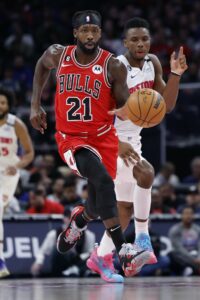 Beverley’s free agency situation is strange. On one hand, the Bulls have gone 10-5 with him in the starting lineup – a very good mark, particularly for a team that has been wildly inconsistent in 2022/23.
Beverley’s free agency situation is strange. On one hand, the Bulls have gone 10-5 with him in the starting lineup – a very good mark, particularly for a team that has been wildly inconsistent in 2022/23.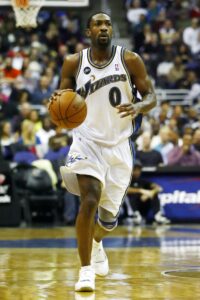 The NBA introduced the Gilbert Arenas provision in the 2005 CBA as a way to help teams retain their restricted free agents who aren’t coming off standard rookie scale contracts. While Arenas isn’t specifically named in the CBA, the rule colloquially known as the Arenas provision stems from his own restricted free agency in 2003.
The NBA introduced the Gilbert Arenas provision in the 2005 CBA as a way to help teams retain their restricted free agents who aren’t coming off standard rookie scale contracts. While Arenas isn’t specifically named in the CBA, the rule colloquially known as the Arenas provision stems from his own restricted free agency in 2003.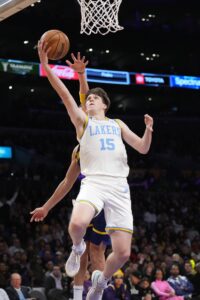 This coming offseason, the best candidate for an Arenas-provision offer sheet is Lakers guard
This coming offseason, the best candidate for an Arenas-provision offer sheet is Lakers guard 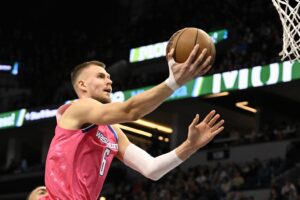
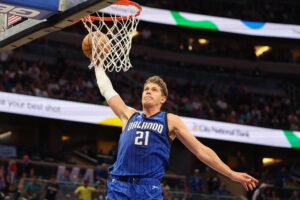 Part of the reason Orlando was comfortable trading
Part of the reason Orlando was comfortable trading  Interestingly, Wiseman is the second former No. 2 overall pick that general manager Troy Weaver has traded for in the past two years, joining
Interestingly, Wiseman is the second former No. 2 overall pick that general manager Troy Weaver has traded for in the past two years, joining 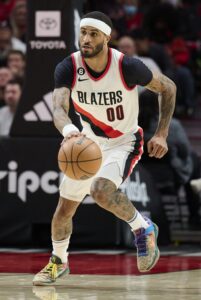 Golden State’s motion offense requires bigs who can set solid (sometimes illegal) screens and make quick decisions with the ball. Neither of those things are strengths of Wiseman’s at the moment.
Golden State’s motion offense requires bigs who can set solid (sometimes illegal) screens and make quick decisions with the ball. Neither of those things are strengths of Wiseman’s at the moment. Still, I highly doubt there was anything nefarious going on. Differences of opinion happen all the time when it comes to medical issues, which is why players often seek out multiple doctors before undergoing surgery.
Still, I highly doubt there was anything nefarious going on. Differences of opinion happen all the time when it comes to medical issues, which is why players often seek out multiple doctors before undergoing surgery. Second, they created about $3MM in salary cap relief by making a four-player
Second, they created about $3MM in salary cap relief by making a four-player  Phoenix was reportedly high on Durant’s list of preferred destinations when he requested a trade this past offseason, but there were rumors of low-ball offers from rival teams and Brooklyn was said to be disinterested in obliging his request.
Phoenix was reportedly high on Durant’s list of preferred destinations when he requested a trade this past offseason, but there were rumors of low-ball offers from rival teams and Brooklyn was said to be disinterested in obliging his request. There’s an alternate reality where the Nets win the title, and maybe everything is different.
There’s an alternate reality where the Nets win the title, and maybe everything is different. Johnson is a quality player as well. His scoring efficiency has taken a hit (.434/.336/.800; .576 TS%) because the Nets are lacking in the shot-creation department, but he’s still averaging career highs in PPG (16.5), RPG (5.0), SPG (1.5) and MPG (31.0) through 15 games with Brooklyn.
Johnson is a quality player as well. His scoring efficiency has taken a hit (.434/.336/.800; .576 TS%) because the Nets are lacking in the shot-creation department, but he’s still averaging career highs in PPG (16.5), RPG (5.0), SPG (1.5) and MPG (31.0) through 15 games with Brooklyn.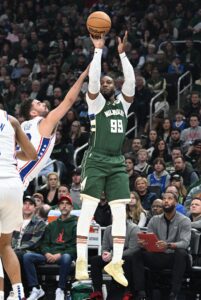 The Bucks had been linked to Crowder for several months, practically as soon as he became publicly available. It was a strange, long, and winding pursuit, but they still ultimately landed him. He later said Milwaukee was his preferred landing spot and that he had
The Bucks had been linked to Crowder for several months, practically as soon as he became publicly available. It was a strange, long, and winding pursuit, but they still ultimately landed him. He later said Milwaukee was his preferred landing spot and that he had  A third-year forward out of Louisville, Nwora showed flashes of upside with Milwaukee, but was unable to carve out a consistent role as a young player on a contending team. The 2020 45th overall pick shot 37.6% from deep in 130 games with the Bucks, but didn’t shoot well on twos (43.9%) and struggled at times defensively.
A third-year forward out of Louisville, Nwora showed flashes of upside with Milwaukee, but was unable to carve out a consistent role as a young player on a contending team. The 2020 45th overall pick shot 37.6% from deep in 130 games with the Bucks, but didn’t shoot well on twos (43.9%) and struggled at times defensively.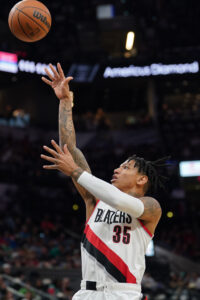 We saw a couple real-life examples of this philosophy at play last summer, when the Trail Blazers waived and stretched
We saw a couple real-life examples of this philosophy at play last summer, when the Trail Blazers waived and stretched 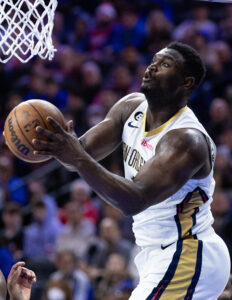
 After going undrafted out of Oklahoma in 2021, Reaves initially caught on with the Lakers on a two-way deal, but received a promotion to a standard contract before his rookie season started. He was one of the bright spots in an otherwise disappointing season in Los Angeles, averaging 7.3 PPG, 3.2 RPG and 1.8 APG on .459/.317/.839 shooting (.600 true shooting percentage) in 61 games (23.2 MPG).
After going undrafted out of Oklahoma in 2021, Reaves initially caught on with the Lakers on a two-way deal, but received a promotion to a standard contract before his rookie season started. He was one of the bright spots in an otherwise disappointing season in Los Angeles, averaging 7.3 PPG, 3.2 RPG and 1.8 APG on .459/.317/.839 shooting (.600 true shooting percentage) in 61 games (23.2 MPG). I was very surprised at how relatively little money DiVincenzo received in his first free agency foray last summer. I know he was coming off a down season in ’21/22 following left ankle surgery and had particularly struggled with his shot – he posted a .351/.339/.843 shooting line in 42 combined games (24.0 MPG) with Milwaukee and Sacramento (.510 TS%).
I was very surprised at how relatively little money DiVincenzo received in his first free agency foray last summer. I know he was coming off a down season in ’21/22 following left ankle surgery and had particularly struggled with his shot – he posted a .351/.339/.843 shooting line in 42 combined games (24.0 MPG) with Milwaukee and Sacramento (.510 TS%). Okogie spent his first four seasons with Minnesota, the team that drafted him 20th overall in 2018. They let him walk after his rookie deal expired, and the 24-year-old was only able to find a veteran’s minimum deal with Phoenix.
Okogie spent his first four seasons with Minnesota, the team that drafted him 20th overall in 2018. They let him walk after his rookie deal expired, and the 24-year-old was only able to find a veteran’s minimum deal with Phoenix.